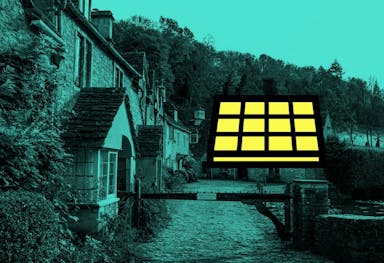- Solar advice hub
- Installation
- Solar panels on slate roofs: an expert guide
Solar panels on slate roofs: an expert guide
How does an installer fit solar panels on a slate roof? Here's why it’s a little more complicated but ultimately worth it.


Why you can trust our content
We know that the solar industry is full of misinformation, but we only use reliable sources, including:
- Our experienced solar experts, installers and system designers
- Our own database of solar & battery system designs
- Authoritative bodies like MCS and the UK government




Calculate savings
What kind of home do you live in?
Calculate savings
What kind of home do you live in?
At a glance
If you have a slate roof and want to go solar, you may be worried that your tiles won’t be able to take the strain.
Thankfully, certified installers now use advanced techniques to ensure that you can get as many solar panels as you like, and still be left with a fully intact roof.
In this guide, we’ll explain how an installer goes about fitting solar panels to a slate roof, why it’s more complicated than most rooftop solar projects, and whether it’s ultimately worth it.
If you’re interested in how much you could save with a solar & battery system, enter a few details below and we’ll provide an estimate.
Find out how much you can save
What kind of home do you live in?
Can you install solar panels on a slate roof?
You can absolutely install solar panels on a slate roof – but it’s more complicated than it is with most roofs.
With enough time, care, and knowledge though, a certified installer can fit a series of solar panels without damaging your tiles or altering the rest of your roof in any noticeable way.
The proof is in the pudding or, in this case, on the slate roofs of countless UK homes that have already gone solar.
Verified expertA solar installation on a slate roof requires a bit more time and skill than a standard install. Unlike normal concrete tiles, every single slate tile is nailed in, and so they need to be removed very carefully. If you just lift up a slate tile and try to wriggle it out, it’ll snap.
Tom Brehme
Technical Manager at Sunsave
Tom has worked in residential solar installation for more than a decade, and is a fully qualified electrician.
Why are slate roof solar installations more complicated?
Slate roof solar installations are more complicated because slate tiles are more fragile and irregular than other types.
On most roofs, solar installers will raise a tile up, hammer a bracket into a rafter, then sit the tile back on the bracket. This isn’t possible with slate, for multiple reasons.
Compared to more common roofing materials like concrete or clay, slate tiles are larger, heavier, and overlap with each other, which all means they can’t be lifted as easily.
Their brittle nature should also stop your installer from drilling or hammering straight through them. Instead, they’ll need to be removed.
Once the brackets are secured, the tiles can be returned to their spots – except slate tiles are too breakable to rest on brackets, so they’ll have to be cut first, to fit around the brackets.

How are solar panels installed on a slate roof?
Solar panels are ideally installed on a slate roof with care and planning, using the steps we’ve explained below.
Good installers will avoid drilling directly through slate tiles. Even if they don’t break completely under the pressure, drilling can affect a slate tile’s structural integrity, making it more vulnerable to leaks.
Verified expertInstalling solar panels on a slate roof won’t damage the tiles if it’s done properly. At Sunsave, we make sure we fix directly onto the rafters, which involves taking some slates out, cutting them, and putting them back in carefully. Some installers just drill directly through the slate, which over time can cause leaks.
Tom Brehme
Technical Manager at Sunsave
Tom has worked in residential solar installation for more than a decade, and is a fully qualified electrician.
1. Tile removal
Your installer will temporarily remove some of the tiles on your roof to clear space for the brackets to be fixed to your rafters.
There will always be a couple of slate tiles on top which have nails they can’t access. They’ll get around this obstacle by using a slate ripper or roof saw to either pull out (or saw through) the nails, so they can extract the tiles without causing any damage.
They’ll then take off a few more tiles, using a hammer’s claw to quickly extract visible nails, and expose the rafter underneath.
In advance of the installation, a good installer will ask to see the underside of your roof or at least some blueprints or a diagram, so they know if your roof is suitable, and which tiles to take off. Otherwise, they may have to use trial and error.
If any tiles are broken in the process, you can expect a good installer to replace them.
2. Roof flashing
The installer will nail a thin film of metal or plastic called ‘flashing’ to the wooden battens in your roof’s structure, under the brackets.
This flashing, which is usually made from lead or zinc, should prevent any water from leaking into your home.
It will also help ensure that your installation complies with the guidelines laid out by top certification bodies, such as Flexi-Orb or the Microgeneration Certification Scheme (MCS).
3. Fit the mounting brackets
With the same nails they use to secure the flashing to your roof, your installer will fit the mounting brackets to your rafters.
When installed properly, these j-shaped devices – which are also known as roof anchors – will hold tight to your roof for countless decades.
And that’s just as well, since they’ll support the rails that keep your panels in place for 40 years or more.
At this stage, your installer may fit a second flashing over the top of the brackets.
4. Cut and replace the tiles
With chalk, a specialist cutting tool, and lots of care, your installer will cut the removed slate tiles to fit around the mounting brackets.
If they’re a top-tier installer, they’ll leave a little extra space on every side, to account for the metal bracket expanding and contracting in different temperatures across the year.
They’ll then replace the tiles on your roof, hammering them in as they go, until they’re fitting so seamlessly that it looks like they’ve never been taken off.
5. Fit the rails and panels
From this point, the installation follows the standard solar guidebook.
Your installation team will fix rails to the mounting brackets, then put solar panels on these rails one by one, locking them in place as they go.
They’ll finish the process off by connecting your inverter to the panels, as well as your consumer unit, also known as a fuse box.

Do slate roof solar installations take longer?
Slate roof solar installations do take longer, typically stretching one or two days longer than the average installation.
As slate tiles are more fragile, your installer will take this extra time to ensure your roof isn’t damaged in the process.
It’s worth waiting a little longer to start enjoying the benefits of solar, so you can rest safe in the knowledge that your roof is just as secure and leak-proof as it was beforehand.
Do slate roof solar installations cost extra?
Solar installations on slate roofs do typically cost extra, as they require more care, time, tools, specialist skills, and replacement tiles than other projects.
Just as it’s worth waiting longer for a better end product, it’s also usually worth paying a bit more for a job well done.
How much more you’ll pay will depend on which company you choose, so it’s worth getting quotes from several trustworthy, accredited installers.
This way, you’ll get a proper sense of how much it currently costs, so you can make an informed decision instead of being persuaded to pay well over the odds.
Next steps
Installing solar panels on a slate roof is a complex task that’s best left to a certified, trusted installer.
Like any specialist task, it pays to get it right – and that’s even more important when it’s your roof on the line.
But if you choose a top-tier installer, you’ll be set to enjoy cuts to your electricity bills and carbon footprint for decades to come, and the slight inconveniences of the installation will seem like a distant memory.
If you’d like to know how much you could save with a solar & battery system, enter a few details below and we’ll provide an estimate.
Find out how much you can save
What kind of home do you live in?
Solar panels on slate roofs: FAQs
Related articles

Written byJosh Jackman
Josh has written about the rapid rise of home solar for the past six years. His data-driven work has been featured in United Nations and World Health Organisation documents, as well as publications including The Eco Experts, Financial Times, The Independent, The Telegraph, The Times, and The Sun. Josh has also been interviewed as a renewables expert on BBC One’s Rip-Off Britain, ITV1’s Tonight show, and BBC Radio 4 and 5.








